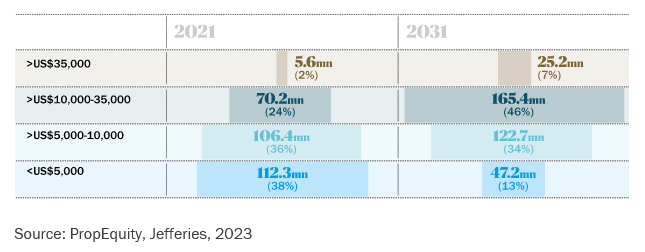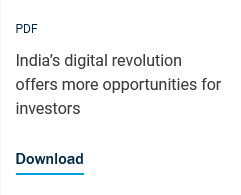
Columbia Threadneede: India’s digital revolution offers more opportunities for investors
The country is in a structural growth cycle, with a focus on reform, infrastructure investment and manufacturing. Alongside favourable demographics, it's making India an easier country in which to do business
28.02.2024 | 12:05 Uhr
In November 2016, on the same day Donald Trump won the US presidential elections, the Indian government announced a massive demonetisation effort, removing the country’s largest bills from circulation, representing 80% of total currency.1 On any normal day this would have been on the front pages of all the major financial publications, however, election of the 45th President of the United States understandably took precedence.
Demonitisation, which initially created tremendous economic upheaval, was part of the government’s ambitious efforts to combat corruption, curb tax evasion and bring more people into the formal economy. It was part of a comprehensive strategy by the government of Prime Minister Narendra Modi to structurally transform the Indian economy. Since he was elected in 2014, Modi has pushed forward economic reforms aimed at fostering a more business-friendly environment, including instituting a national goods and services tax (GST). This streamlined the complicated web of state taxes and helped bring the manufacturing and industrial sectors into the formal economy. He also revised the Insolvency and Bankruptcy code which facilitated improving capital allocation and the cost of credit.
Many market participants did not connect the dots at the time, but the digitalisation of the Indian economy, known as IndiaStack, was a core part of the government’s strategic thinking. This digital public infrastructure is best understood as a public utility and it could have enormous implications for the people of India and its economy. It could also present new and compelling investment opportunities.
Understanding India’s digital evolution and revolution
The potential significance of IndiaStack is best understood through an example: Prema is a 23-year-old born in a rural Indian village who recently migrated to Mumbai in pursuit of better opportunities. But without a permanent address Prema would fall at the first hurdle when trying to open a bank account. Here’s how IndiaStack works for her:
- Identify: The first layer of IndiaStack is AADHAR, a biometric identity database, which links Prema’s national ID to her biometric data so she can open a bank account and financial service providers can conduct “know your customer” checks.
- Payments: Next, the Unified Payments Interface (UPI) enables cashless payments by linking Prema’s ID number, phone number and bank account to a payment address. This allows her to receive her salary electronically. It also enables her to send money back to her parents or shop at the local market, all on her smartphone and without a costly middleman.
- Data: The final layer, DigiLocker and e-consent, allows Prema to store copies of documents like academic records, birth certificate and driver’s licence. She can share these with potential employers or financial service companies to apply for loans.
Together with India’s demographic and income trends, these reforms could support continued economic development and growth. India is the world’s most populous country, with a median age of 29,2 recently breaking the $2,000 GDP-per-capita level,3 and a rapidly expanding middle class – the number of households earning in excess of $35,000 a year4 is expected to rise fivefold in the coming decade (Figure 1). It is estimated that more than 40%5 of the Indian economy is informal. Digitisation has the potential to bring many people into the formal economy, for example by facilitating access to credit. The reforms have also revolutionised credit underwriting and streamlined lending, which should result in a significant pick up in loan growth, boosting the financial sector and the economy. We’ve also witnessed an explosion in retail investing with a potential quintupling of stock market participants from 62 million to around 300 million.6
Digitisation has the potential to bring many people into the formal economy, for example by facilitating access to credit.
Figure 1: India’s income pyramid is forecast to invert within the next decade

India’s structural growth story is not just limited to digitalisation, population and wealth creation. The government is investing in massive infrastructure projects and supporting the development of its manufacturing sector in a bid to increase foreign direct investment and kick-start substantial network effects in supply chains, as the economy seizes the opportunity of China+1 diversification efforts by multinational corporates.
1 American Economic Association, 2020
2 Worldometer. 2023
3 Citi Research. 2023
4 Jefferies. 2023
5 World Economics. 2023
6 Morgan Stanley. 2023
Risk Disclaimer
For use by professional clients and/or equivalent investor types in your jurisdiction (not to be used with or passed on to retail clients). This is a marketing communication. The mention of stocks is not a recommendation to deal.
This document is intended for informational purposes only and should not be considered representative of any particular investment. This should not be considered an offer or solicitation to buy or sell any securities or other financial instruments, or to provide investment advice or services. Investing involves risk including the risk of loss of principal. Your capital is at risk. Market risk may affect a single issuer, sector of the economy, industry or the market as a whole. The value of investments is not guaranteed, and therefore an investor may not get back the amount invested. International investing involves certain risks and volatility due to potential political, economic or currency fluctuations and different financial and accounting standards. The securities included herein are for illustrative purposes only, subject to change and should not be construed as a recommendation to buy or sell. Securities discussed may or may not prove profitable. The views expressed are as of the date given, may change as market or other conditions change and may differ from views expressed by other Columbia Threadneedle Investments (Columbia Threadneedle) associates or affiliates. Actual investments or investment decisions made by Columbia Threadneedle and its affiliates, whether for its own account or on behalf of clients, may not necessarily reflect the views expressed. This information is not intended to provide investment advice and does not take into consideration individual investor circumstances. Investment decisions should always be made based on an investor’s specific financial needs, objectives, goals, time horizon and risk tolerance. Asset classes described may not be suitable for all investors. Past performance does not guarantee future results, and no forecast should be considered a guarantee either. Information and opinions provided by third parties have been obtained from sources believed to be reliable, but accuracy and completeness cannot be guaranteed. This document and its contents have not been reviewed by any regulatory authority.
In Australia: Issued by Threadneedle Investments Singapore (Pte.) Limited [“TIS”], ARBN 600 027 414. TIS is exempt from the requirement to hold an Australian financial services licence under the Corporations Act and relies on Class Order 03/1102 in marketing and providing financial services to Australian wholesale clients as defined in Section 761G of the Corporations Act 2001. TIS is regulated in Singapore (Registration number: 201101559W) by the Monetary Authority of Singapore under the Securities and Futures Act (Chapter 289), which differ from Australian laws.
In Singapore: Issued by Threadneedle Investments Singapore (Pte.) Limited, 3 Killiney Road, #07-07, Winsland House 1, Singapore 239519, which is regulated in Singapore by the Monetary Authority of Singapore under the Securities and Futures Act (Chapter 289). Registration number: 201101559W. This advertisement has not been reviewed by the Monetary Authority of Singapore.
In Hong Kong: Issued by Threadneedle Portfolio Services Hong Kong Limited 天利投資管理香港有限公司. Unit 3004, Two Exchange Square, 8 Connaught Place, Hong Kong, which is licensed by the Securities and Futures Commission (“SFC”) to conduct Type 1 regulated activities (CE:AQA779). Registered in Hong Kong under the Companies Ordinance (Chapter 622), No. 1173058.
In Japan: Issued by Columbia Threadneedle Investments Japan Co., Ltd. Financial Instruments Business Operator, The Director-General of Kanto Local Finance Bureau (FIBO) No.3281, and a member of Japan Investment Advisers Association and Type II Financial Instruments Firms Association.
In the UK: Issued by Threadneedle Asset Management Limited. Registered in England and Wales, Registered No. 573204, Cannon Place, 78 Cannon Street, London EC4N 6AG, United Kingdom. Authorised and regulated in the UK by the Financial Conduct Authority.
In the EEA: Issued by Threadneedle Management Luxembourg S.A. Registered with the Registre de Commerce et des Societes (Luxembourg), Registered No. B 110242, 44, rue de la Vallée, L-2661 Luxembourg, Grand Duchy of Luxembourg.
In Switzerland: Issued by Threadneedle Portfolio Services AG, Registered address: Claridenstrasse 41, 8002 Zurich, Switzerland.
In the Middle East: This document is distributed by Columbia Threadneedle Investments (ME) Limited, which is regulated by the Dubai Financial Services Authority (DFSA). For Distributors: This document is intended to provide distributors’ with information about Group products and services and is not for further distribution. For Institutional Clients: The information in this document is not intended as financial advice and is only intended for persons with appropriate investment knowledge and who meet the regulatory criteria to be classified as a Professional Client or Market Counterparties and no other Person should act upon it.





Diesen Beitrag teilen: